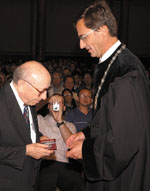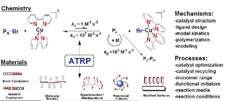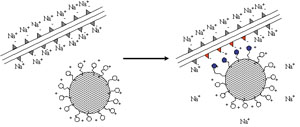|
|
Vol.
28 No. 3
May-June 2006
Polymers for Advanced Technologies
by György Bertalan, György Marosi, and Andrea Toldy
 |
| Menachem Lewin (left), the honorary chairman of PAT—founder of the PAT Symposium and the PAT journal—received a ZEMPLÉN award from Prof. György POKOL (Dean of the Faculty of Chemical Engineering of Budapest University of Technology and Economics) for propagation of the results of international and Hungarian science. |
The
8th International
Symposium on Polymers for Advanced Technologies (PAT)
2005, held in Budapest, 13–16 September 2005, was organized
by the Budapest University of Technology and Economics, and
under the auspices of IUPAC, the European Polymer Federation,
Society of Polymer Science Japan, Chemical Society of Japan,
Polymer and PMSE Divisions of the American Chemical Society,
Budapest University of Technology and Economics, and Hungarian
Academy of Sciences.
More than 350 active participants attended the conference, among them experienced researchers and younger scientists, leading specialists in various domains of the polymer industry, and student representatives of numerous universities.
The scientific program consisted of eight plenary and 44 invited lectures, about 120 oral presentations, and about 140 posters. The presentations covered not only the cutting edge and new trends in contemporary technological methods, but also basic research on new processes. Particularly emphasized were various methods of polymer synthesis that result in special architecture. The oral presentations were organized into four sections, covering the major domains of polymer technology:
- Section A — Advanced Macro-molecular Syntheses/Structures
- Section B — Advanced Multicomponent Systems, Nanocomposites
- Section C — Electro-Optical and Other Advanced Technologies
- Section D — Biomedical Application, Biodegradation
The plenary lectures were devoted to cutting-edge and contemporary topics related to a number of advanced polymer technologies, as well as associated basic research. Topics included water purification through plastic optical fibers, nanostructured polymer materials created via atom transfer radical polymerization (ATRP) grafting or inclusion of nanotubes, and the use of photo- and thermally sensitive polymers as templates and surface patterning components. Prof. J. Economy cited a U.S. intelligence report that states that by the year 2015, water—not energy or food—will become the major problem resource in the United States and throughout the world. A number of new systems for trace-contaminant removal were described (e.g., new and improved high-surface-area adsorbent polymer fibers designed to remove trace contaminants to below 1 part per billion). Prof. P. Hodge addressed the theoretical and technological aspects of ring-chain equilibria, including an introduction to entropically-driven ring-opening polymerization (ED-ROP), discussing the useful features of ED-ROPs, the preparation of macrocyclic oligomers, and possible practical applications. Prof. K. Matyjaszewski spoke on recent polymer syntheses using ATRP of acrylates, methacrylates, styrenes, acrylamides, acrylonitrile, and many other vinyl monomers to create polymers with a large range of molecular weights and with low polydispersities.
A discussion of the development of plastic optical fiber materials (POF) was presented by Prof. Y. Okamoto. POF has been increasingly applied to computer LANs. Along with several other advantageous properties, the elastic moduli of POF are typically many times lower than those of silica. Prof. B. Voit gave an especially interesting presentation demonstrating the applicability of photo- and thermally labile polymers for template formation and surface patterning.
Section A of the oral presentations included discussions on a wide range of contemporary synthesis methods. Various basic materials were used for synthesis, including naturally occurring polymers (W.H. Daly), novel block copolymers (R. Faust), functionalized polymers (F. D’Agosto), nanocomposites, nanoparticles, biodegradable polymers, charge-transporting polymers, polymers used for biomacromolecular engineering, smart amphiphilic, and polymer networks.
Section B included presentations on a large variety of multicomponent polymer systems, their processing, properties, and applications. Several presentations devoted to the structure-properties relationship elucidated not only the functional modification of composites, but also the role of surface and interface modification. Presentations covering the use of nanocomposites as fire retardants represented another significant aspect of Section B. An important phenomenon, the migration of clay and structural changes in nanocomposites occurring upon annealing at elevated temperatures, was discussed by Prof. M. Lewin.
 |
| Chemistry, mechanisms, materials synthesized, and processes arising from ATRP, as presented by Prof. K. Matyjaszewski. |
Section C covered a great variety of methods, special materials, and devices, such as sensors, electroluminescents in polymer composites, polymer gels as promising technological smart materials, latex-coated polymer materials as synthetic mimics for micrometeorites, and nanostructure polymer membranes for use in fuel cells. Particular interest was generated by a presentation on polymers as functional components in batteries and fuel cells (G. Wegner).
Section D covered a great number of biodegradable, biocompatible polymers, and their application as carriers for drug delivery and for surface modification, as well as stimuli-responsive and smart polymers. Biodegradable polymers synthesized from fatty acids have been used as injectable carriers for delivery of small drug molecules as well as peptides and proteins (A. Domb). An especially important biomaterial has revolutionized cardiology through the use of metal stents coated with poly (styrene-Β-isobutylene-Β-styrene) triblock copolymers (SIBS) that release a restenosis-preventing drug. This device has already been implanted in ~1 000 000 patients and reduced the need for invasive coronary bypass surgery by ~85% (J.P. Kennedy). Polymer nanofibers and nanotubes were also discussed as showing promise for medical applications (J.H. Wendorff). The roles of polymer networks, hydrogels, and polymer-based micro- and nanoparticles in controlled drug-delivery systems were also discussed (I. Eros).
The final presentation and closing remarks, made by the chairman of the conference (Gy. Marosi), focused on the convergent trends of advanced technologies. Polymer science and technology was long divided into several branches that developed almost independently. Due to specialization, there was only limited interaction between the research fields of natural and synthetic, hydrophilic and thermoplastic, and linear and cross-linked polymers. This situation is changing, however, as the gap between the different areas of research is gradually narrowing. Convergent concepts can be seen in the areas of advanced polymer systems used as pharmaceuticals, biomaterials, polymer composites, fire retardants, membranes, conductive polymer systems, and polymers used in fuel cells. The widespread use of the ATRP technique, the increasing importance of the controlled synthesis of nanostructures, special interface modifiers allowing the use of in-line controlled reactive processing methods, and advanced surface engineering/analysis are examples of the tendency toward convergence. Examples presented in the last talk of the conference included the use of process control for the synthesis of reactive surfactants and polymer dispersions intercalated with nanolayers, as shown in the figure below.
 |
| Intercalated montmorillonite structure formed by emulsion polymerization, presented by Marosi. |
Such a structure is advantageous both for the controlled release of drugs from solid pharmaceuticals and for activating the protection mechanism in fire-retardant polymer systems. Raman microscopy is a method that is universally applicable in all advanced polymer technologies, and thus also represents a convergence of research areas. Quantitative chemical mapping of complex composites and pharmaceuticals, determination of polymorph structures at interphases of various macromolecular systems, and in-line detection of reactive extrusion of synthetic and biopolymers have been performed using the Raman system. Nanotubes as potential components of composites for drug delivery or in flame-retardant systems have also been analyzed in this manner. Lastly, the fire retardancy of biodegradable polymers is an excellent example of the convergence of different fields. The tendency toward convergence was clearly evident at the Budapest symposium and will surely continue to increase in Shanghai at PAT 2007.
The abstracts of all presentation are available at <www.bme.hu/pat2005>.
György Marosi <[email protected]>, a professor in the Department of Organic Chemical Technology at the Budapest University of Technology and Economics, served as chairman of the local organizing committee. Bertalan and Toldy were also members of the local organzing committee.
Page
last modified 25 April 2007.
Copyright © 2003-2007 International Union of Pure and
Applied Chemistry.
Questions regarding the website, please contact [email protected]
|